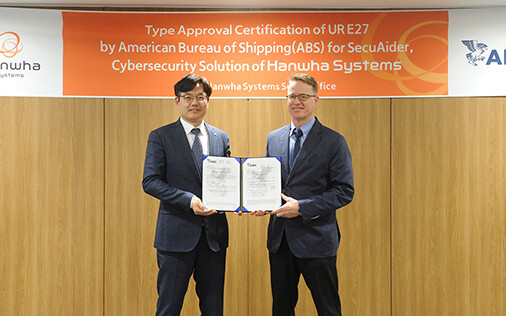The American Bureau of Shipping (ABS) has granted Type Approval to Hanwha Systems’ SecuAider® software for meeting the IACS UR E27 cyber resilience requirements. The approval marks a significant step in bolstering maritime cybersecurity as vessels increasingly integrate digital systems vulnerable to cyber threats.
SecuAider® is designed to protect a ship’s data and networks from cyberattacks, including ransomware and malware, the ABS press release said. The software is installed within the vessel’s network and connected to onboard systems and equipment. Hanwha Systems vice president and naval business division leader Myeong Seob Cho said in a prepared statement that SecuAider® provides real-time analysis and control of cyber threats without degrading the performance of existing onboard systems.
The certification comes as part of the ABS Cyber Resilience Program, which assesses the security measures implemented during the design, construction, commissioning, and operational phases of digitally enabled systems.
The U.S. Government Accountability Office (GAO) recently released a report identifying “significant and increasing” cybersecurity risks to the Maritime Transportation System (MTS). The report outlines critical vulnerabilities and provides recommendations to enhance cybersecurity protections for maritime facilities and vessels.
According to the report, cyber threats to the MTS are escalating, with state-sponsored actors, transnational criminal organizations, and other malicious entities posing significant risks. The accessibility of commercial cyberattack tools has lowered the barrier for launching disruptive cyber incidents, increasing the likelihood of attacks on maritime networks. The GAO noted that MTS facilities and vessels rely on interconnected networks, making them vulnerable to cyberattacks that could disrupt port operations and cargo movement, potentially leading to severe national security and economic consequences.
The report highlighted the Coast Guard’s role in assisting and overseeing cybersecurity efforts within the MTS. The agency provides technical support, voluntary cybersecurity guidelines, and cyber threat intelligence to maritime operators, and also conducts facility and vessel inspections to identify cybersecurity deficiencies. In January, the Coast Guard finalized new maritime security regulations to address evolving cybersecurity risks within MTS.
However, the GAO found that the Coast Guard lacks a streamlined method to access complete cybersecurity-related inspection data, limiting its ability to oversee and mitigate risks effectively. The report identified shortcomings in the Coast Guard’s ability to access and analyze cybersecurity-related inspection data, limiting its effectiveness in overseeing and mitigating cyber risks.
As cyber threats in the maritime sector continue to rise, solutions like SecuAider® play a vital role in safeguarding vessel operations. ABS’ certification highlights the importance of proactive cybersecurity measures to protect ships and their digital infrastructure.
In a guide to best strengthen cybersecurity measures, WorkBoat spoke with retired Navy Rear Adm. Gene Price, former Commander of the Office of Naval Intelligence, Commander of Naval Information Forces Reserve, and director of the National Maritime Intelligence Integration Office.




